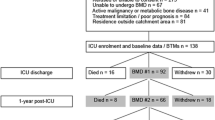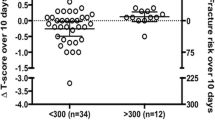Abstract
Summary
The contribution of premorbid bone health to accelerated bone loss following critical illness is unknown. This study compared bone density in women before critical illness to women who did not become critically ill. Overall bone density was similar, although femoral neck bone mass increased immediately prior to critical illness.
Purpose
The relative contribution of acute and chronic factors to accelerated loss of bone mineral density (BMD) following critical illness is unknown. This study compared the BMD trajectory of women before critical illness to the BMD trajectory of women who did not become critically ill.
Methods
This prospective, nested, age- and medication-matched, case-control study compared trajectory of BMD in women in the Geelong Osteoporosis study (GOS) requiring admission to an Australian Intensive Care Unit (ICU) between June 1998 and March 2016, to women not admitted to ICU. The main outcome was age and medication use adjusted change in BMD.
Results
A total of 52 women, with a mean age of 77 ± 9 years were admitted to ICU, predominantly post-surgery (75%), during the study period. A greater age-adjusted annual rate of decline was observed for pre-ICU women compared to no-ICU women for AP spine BMD (−0.010 ± 0.002 g/cm2 vs −0.005 ± 0.002 g/cm2, p = 0.01) over the 15-year study period. In participants with multiple BMDs 2 years before critical illness, a significantly greater increase in femoral neck BMD compared to age- and medication-matched controls was observed (difference in BMD, ICU vs no-ICU = 0.037 ± 0.013 g/cm2, p = 0.006).
Conclusion
In a cohort of women with predominantly surgical ICU admission, bone health prior to critical illness was comparable to age- and medication-matched controls, with a relative increase in femoral neck bone mass immediately prior to critical illness. These findings suggest critical illness-related bone loss cannot be entirely explained as a continuation of pre-morbid bone trajectory.



Similar content being viewed by others
References
Orford N, Cattigan C, Brennan SL, Kotowicz M, Pasco J, Cooper DJ (2014) The association between critical illness and changes in bone turnover in adults: a systematic review. Osteoporos Int 25(10):2335–2346. https://doi.org/10.1007/s00198-014-2734-1
Orford NR, Lane SE, Bailey M, Pasco JA, Cattigan C, Elderkin T, Brennan-Olsen SL, Bellomo R, Cooper DJ, Kotowicz MA (2016) Changes in bone mineral density in the year after critical illness. Am J Respir Crit Care Med 193(7):736–744. https://doi.org/10.1164/rccm.201508-1514OC
Orford NR, Bailey M, Bellomo R, Pasco JA, Cattigan C, Elderkin T, Brennan-Olsen SL, Cooper DJ, Kotowicz MA (2017) The association of time and medications with changes in bone mineral density in the 2 years after critical illness. Crit Care 21(1):69. https://doi.org/10.1186/s13054-017-1657-6
Orford NR, Saunders K, Merriman E, Henry M, Pasco J, Stow P, Kotowicz M (2011) Skeletal morbidity among survivors of critical illness. Crit Care Med 39(6):1295–1300. https://doi.org/10.1097/CCM.0b013e318211ff3d
Ferrante LE, Pisani MA, Murphy TE, Gahbauer EA, Leo-Summers LS, Gill TM (2015) Functional trajectories among older persons before and after critical illness. JAMA Intern Med 175(4):523–527. https://doi.org/10.1001/jamainternmed.2014.7889
Pasco JA, Nicholson GC, Kotowicz MA (2012) Cohort profile: Geelong Osteoporosis Study. Int J Epidemiol 41(6):1565–1575. https://doi.org/10.1093/ije/dyr148
Seeman E (2002) Pathogenesis of bone fragility in women and men. Lancet 359(9320):1841–1850. https://doi.org/10.1016/S0140-6736(02)08706-8
Sambrook P, Cooper C (2006) Osteoporosis. Lancet 367(9527):2010–2018. https://doi.org/10.1016/S0140-6736(06)68891-0
Henry MJ, Pasco JA, Nicholson GC, Seeman E, Kotowicz MA (2000) Prevalence of osteoporosis in Australian women: Geelong Osteoporosis Study. J Clin Densitom 3(3):261–268
Nierman DM, Mechanick JI (1998) Bone hyperresorption is prevalent in chronically critically ill patients. Chest 114(4):1122–1128
Lind L, Carlstedt F, Rastad J, Stiernström H, Stridsberg M, Ljunggren Ö, Wide L, Larsson A, Hellman P, Ljunghall S (2000) Hypocalcemia and parathyroid hormone secretion in critically ill patients. Crit Care Med 28(1):93–99
Nierman DM, Mechanick JI (2000) Biochemical response to treatment of bone hyperresorption in chronically critically ill patients. Chest 118(3):761–766
Van den Berghe G, Baxter RC, Weekers F et al (2002) The combined administration of GH-releasing peptide-2 (GHRP-2), TRH and GnRH to men with prolonged critical illness evokes superior endocrine and metabolic effects compared to treatment with GHRP-2 alone. Clin Endocrinol 56(5):655–669
Van den Berghe G, Weekers F, Baxter RC et al (2001) Five-day pulsatile gonadotropin-releasing hormone administration unveils combined hypothalamic-pituitary- gonadal defects underlying profound hypoandrogenism in men with prolonged critical illness*. J Clin Endocrinol Metab 86(7):3217–3226
Van den Berghe G, Wouters P, Weekers F et al (1999) Reactivation of pituitary hormone release and metabolic improvement by infusion of growth hormone- releasing peptide and thyrotropin-releasing hormone in patients with protracted critical illness*. J Clin Endocrinol Metab 84:1311–1323
Owen HC, Vanhees I, Solie L, Roberts SJ, Wauters A, Luyten FP, van Cromphaut S, van den Berghe G (2012) Critical illness-related bone loss is associated with osteoclastic and angiogenic abnormalities. J Bone Miner Res 27(7):1541–1552. https://doi.org/10.1002/jbmr.1612
Van den Berghe G (2003) Bone turnover in prolonged critical illness: effect of vitamin D. J Clin Endocrinol Metab 88(10):4623–4632. https://doi.org/10.1210/jc.2003-030358
Smith LM, Cuthbertson B, Harvie J, Webster N, Robins S, Ralston SH (2002) Increased bone resorption in the critically ill: association with sepsis and increased nitric oxide production. Crit Care Med 30(4):837–840
Shapses SA, Weissman C, Seibel MJ, Chowdhury HA (1997) Urinary pyridinium cross-link excretion is increased in critically ill surgical patients. Crit Care Med 25(1):85–90
Schwetz V, Schnedl C, Urbanic-Purkart T, Trummer C, Dimai HP, Fahrleitner-Pammer A, Putz-Bankuti C, Christopher KB, Obermayer-Pietsch B, Pieber TR, Dobnig H, Amrein K (2017) Effect of vitamin D3 on bone turnover markers in critical illness: post hoc analysis from the VITdAL-ICU study. Osteoporos Int 28:1–8. https://doi.org/10.1007/s00198-017-4190-1
Koch A, Weiskirchen R, Ludwig S, Buendgens L, Bruensing J, Yagmur E, Baeck C, Herbers U, Trautwein C, Tacke F (2017) Relevance of serum sclerostin concentrations in critically ill patients. J Crit Care 37(C):38–44. https://doi.org/10.1016/j.jcrc.2016.08.019
Gavala A, Makris K, Korompeli A, Myrianthefs P (2016) Evaluation of bone metabolism in critically ill patients using CTx and PINP. Biomed Res Int 2016(4):1–9. https://doi.org/10.1155/2016/1951707
Rawal J, McPhail MJ, Ratnayake G et al (2015) A pilot study of change in fracture risk in patients with acute respiratory distress syndrome. Crit Care 19(1):165. https://doi.org/10.1186/s13054-015-0892-y
Lee P, Ng C, Slattery A, Nair P, Eisman JA, Center JR (2016) Preadmission bisphosphonate and mortality in critically ill patients. J Clin Endocrinol Metab 101(5):1945–1953. https://doi.org/10.1210/jc.2015-3467
Bagshaw SM, Stelfox HT, Johnson JA, McDermid RC, Rolfson DB, Tsuyuki RT, Ibrahim Q, Majumdar SR (2015) Long-term association between frailty and health-related quality of life among survivors of critical illness. Crit Care Med 43(5):973–982. https://doi.org/10.1097/CCM.0000000000000860
Schwetz V, Schnedl C, Urbanic-Purkart T, Trummer C, Dimai HP, Fahrleitner-Pammer A, Putz-Bankuti C, Christopher KB, Obermayer-Pietsch B, Pieber TR, Dobnig H, Amrein K (2017) Effect of vitamin D3 on bone turnover markers in critical illness: post hoc analysis from the VITdAL-ICU study. Osteoporos Int 28(12):3347–3354. https://doi.org/10.1007/s00198-017-4190-1
Via MA, Potenza MV, Hollander J, Liu X, Peng Y, Li J, Sun L, Zaidi M, Mechanick JI (2012) Intravenous Ibandronate acutely reduces bone hyperresorption in chronic critical illness. J Intensive Care Med 27(5):312–318. https://doi.org/10.1177/0885066611402156
Kastritis E, Gavriatopoulou M, Dimopoulos MA, Eleutherakis-Papaiakovou E, Kanellias N, Roussou M, Pamboucas C, Toumanidis ST, Terpos E (2015) Osteoprotegerin is a significant prognostic factor for overall survival in patients with primary systemic amyloidosis independent of the Mayo staging. Blood Cancer J 5(6):e319. https://doi.org/10.1038/bcj.2015.45
Lerchbaum E, Schwetz V, Pilz S, Boehm BO, März W (2013) Association of bone turnover markers with mortality in women referred to coronary angiography: the Ludwigshafen Risk and Cardiovascular Health (LURIC) study. Osteoporos Int 25(2):455–465. https://doi.org/10.1007/s00198-013-2411-9
Lerchbaum E, Schwetz V, Pilz S, Grammer TB, Look M, Boehm BO, Obermayer-Pietsch B, März W (2012) Association of bone turnover markers with mortality in men referred to coronary angiography. Osteoporos Int 24(4):1321–1332. https://doi.org/10.1007/s00198-012-2076-9
Levinger I, Brennan-Speranza TC, Zulli A, Parker L, Lin X, Lewis JR, Yeap BB (2017) Multifaceted interaction of bone, muscle, lifestyle interventions and metabolic and cardiovascular disease: role of osteocalcin. Osteoporos Int 28:1–9. https://doi.org/10.1007/s00198-017-3994-3
Lee P, Nair P, Eisman JA, Center JR (2016) Bone failure in critical illness. Crit Care Med 44(12):2270–2274. https://doi.org/10.1097/CCM.0000000000001874
Grey A, Bolland MJ (2013) The effect of treatments for osteoporosis on mortality. Osteoporos Int 24(1):1–6. https://doi.org/10.1007/s00198-012-2176-6
Author information
Authors and Affiliations
Contributions
Substantial contributions to the conception (NO, RB, DC, MB, JP, MK) or design (NO, MB, JP, RB, DC, MK) of the work; or the acquisition, analysis, or interpretation of data (NO, MB, JP, RB, DC, MK) for the work.
Drafting the work or revising it critically for important intellectual content (NO, MB, JP, RB, DC, MK).
Final approval of the version to be published (NO, MB, JP, RB, DC, MK).
Agreement to be accountable for all aspects of the work in ensuring that questions related to the accuracy or integrity of any part of the work are appropriately investigated and resolved. (NO, MB, JP, RB, DC, MK).
Corresponding author
Ethics declarations
Conflict of interest
None.
Electronic supplementary material
ESM 1
(DOCX 245 kb)
Rights and permissions
About this article
Cite this article
Orford, N.R., Bailey, M., Bellomo, R. et al. Changes in bone mineral density in women before critical illness: a matched control nested cohort study. Arch Osteoporos 13, 119 (2018). https://doi.org/10.1007/s11657-018-0533-6
Received:
Accepted:
Published:
DOI: https://doi.org/10.1007/s11657-018-0533-6




